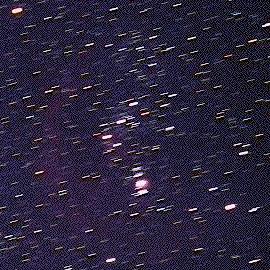![[Barnard's Loop, Peter Erdman]](../../Pics/Ngc/b-loops.jpg)
Barnard's Loop
| Right Ascension | 5 : 31 (h:m) |
|---|---|
| Declination | -4.9 (deg) |
| Distance | 1.6 (kly) |
| Visual Brightness | ? (mag) |
| Apparent Dimension | 1200 (arc min) |
Probably discovered by William Herschel on February 1, 1786. Discovered by E.E. Barnard around 1900.
Barnard's loop is a remarkable nebula enveloping a great part of the huge Orion cloud, or complex, it seems to be associated with. It was perhaps discovered by William Herschel on February 1, 1786, and finally found again by E.E. Barnard who called it "Orion Loop."
While difficult to be observed visually, it can be well photographed on long exposures.
It is speculated that this nebula may be a supernova remnant. This theory was brought up by Öpik 1953, but opposed e.g. by Menan who suggested it might be simply a diffuse emission nebula excited by hot stars. More recently it was found that this huge nebula is probably the ionized inner surface of an even larger hydrogen cloud envelopping a vast region of space which contains hot, ionized gas of low density, and the Orion OB1 association, a group of very hot young stars of spectral types O and B. This large "bubble" was possibly formed by a series of supernova explosions, perhaps about 3 million years ago.
UV observations have shown that Barnhard's Loop is also visible in the ultraviolet light - as a reflection nebula shining in scattered starlight. The reflection of its dust particles is apparently most efficient in thtat part of the spectrum, and coincides with the maximal light intensity of O and B stars.
Semi-recently, it was found that an even larger UV reflection nebula exists in this region of space, reaching far beyond Barnard's Loop. This nebula has an apparent diameter of over 30 degrees.
The image above was obtained by Peter Erdman, with a 35-mm lens at f/4,
in the H alpha light; exposure time about 4 hours. Barnard's Loop stands out
prominently in this image of the southern two-third of constellation Orion,
as does the Orion Nebula region; M42 and
M43 are clearly visible, as are the bright
nebulae NGC 2024 (Orion B) and IC 343 in the Horsehead Nebula region.
M78 is more difficult as it is inconspicuous
in H alpha, but can be found in the
large version of this image, which shows
a lot of more detail in the fainter nebula. The bright star on the lower right
in this image, just about at the end of the extension of the loop, is Rigel
(Beta Orionis).
 The image on the right shows faint Barnard's Loop on a star trail exposure
of constellation Orion obtained by Alexander Jäger of the
Interessengemeinschaft Astronomie (Astronomy Interest Group) at the
University of Constance.
Other parts of the Orion cloud, such as
the Orion Nebula
M42/M43 and the
Horsehead Nebula region can also be easily identified
in this image, as well as Orion's major stars.
The extended image shows also the
Rosette Nebula.
Alexander took this image with a 50 mm f/1.4 photo lens stopped to f/2,
exposed 2 minutes on Kodak Ektachrome Panther P1600X film from the
Schwäbische Alb, South Germany.
The image on the right shows faint Barnard's Loop on a star trail exposure
of constellation Orion obtained by Alexander Jäger of the
Interessengemeinschaft Astronomie (Astronomy Interest Group) at the
University of Constance.
Other parts of the Orion cloud, such as
the Orion Nebula
M42/M43 and the
Horsehead Nebula region can also be easily identified
in this image, as well as Orion's major stars.
The extended image shows also the
Rosette Nebula.
Alexander took this image with a 50 mm f/1.4 photo lens stopped to f/2,
exposed 2 minutes on Kodak Ektachrome Panther P1600X film from the
Schwäbische Alb, South Germany.
![[SEDS]](../../Jco/seds1.jpg)
![[MAA]](../../Jco/maa.jpg)
![[Home]](../../Jco/messier.jpg)
![[Non-Messier Indexes]](../../Jco/ngc.ico.jpg)
Last Modification: August 14, 2007